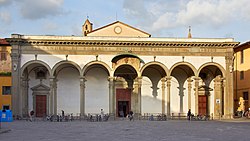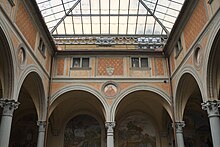Santissima Annunziata, Florence
| Basilica della Santissima Annunziata | |
|---|---|
 | |
 |
The Basilica della Santissima Annunziata (Basilica of the Most Holy Annunciation) is a Renaissance-style, Catholic minor basilica in Florence, region of Tuscany, Italy. This is considered the mother church of the Servite Order. It is located at the northeastern side of the Piazza Santissima Annunziata near the city center.
History
[edit]

The church was founded in 1250 by the seven original members of the Servite Order. In 1252, a painting of the Annunciation had been begun by a friar Bartolomeo, commissioned by the Servite monks. It is said he despaired about being able to paint a virgin with a beautiful enough face, and fell asleep, only to find the painting completed. This miracle he attributed to an angel.[1] The painting now housed in the church, acquired increasing veneration, such that in 1444 the Gonzaga family from Mantua financed a special tribune. Initially Michelozzo, who was the brother of the Servite prior, was commissioned to build it, but since Ludovico III Gonzaga had a special admiration for Leon Battista Alberti, this latter architect was given the commission in 1469. Alberti's designs were constricted by the pre-existing foundations. Construction was completed in 1481, after Alberti's death. Though the structure was refurbished in Baroque-style in the seventeenth century, the basic scheme of a domed circular space flanked by altar niches is still evident.[2]
The façade of the church was added in 1601 by the architect Giovanni Battista Caccini, imitating the Renaissance-style of Brunelleschi's façade of the Foundling Hospital, which defines the eastern side of the piazza. The building across from the Foundling Hospital, designed by Sangallo the Elder, was also given a Brunelleschian façade in the 1520s.
Veneration
[edit]
Pilgrims who came to the church to venerate the miraculous painting often left wax votive offerings, many of them life-size models of the donor (sometimes complete with horses). In 1516, a special atrium was built to house these figures, the Chiostrino dei Voti. By the late 18th century there were some six hundred of these images and they had become one of the city's great tourist attractions. In 1786, however, they were all melted down to make candles.
Pope Alexander VI, in appreciation for the survival of Rome after French occupation, paid homage and gifted a silver effigy to the church.[3]
The Florentine brides traditionally visit the shrine to leave their bouquets.

This church is entered from the Chiostrino dei Voti. The Baroque decoration of the church interior was begun in 1644, when Pietro Giambelli frescoed the ceiling with an Assumption as a centerpiece based on designs by Baldassare Franceschini.
The 1st chapel to right contains a Madonna in Glory by Jacopo da Empoli, with walls frescoed by Matteo Rosselli. The 5th chapel on the right contains a Monument to Orlando de' Medici (1456) by Bernardo Rossellino. The right transept has a small side chapel has a Pietà (1559) by Baccio Bandinelli and graces his tomb.
The chapel-surrounded tribune or choir, known as the Rotonda, was designed in turn by Michelozzo and Alberti between 1444 and 1476. Notable among the chapels is the fifth (aligned to nave axis), which has a crucifix (1594–8) by Giambologna for his tomb, with statues of the "Active and Contemplative Lives" by his pupil Francavilla, saints and angels by Pietro Tacca,[5] and murals by Bernardino Poccetti. The next chapel has a Resurrection (1548–52) by Bronzino with a statue of St Roch attributed to Veit Stoss. The next chapel has a Madonna with Saints by a follower of Perugino.
In the sixth chapel to the left of the nave is a SS Ignatius, Erasmus and Blaise by Raffaellino del Garbo; the next chapel has one of the panels of Annunziata Altarpiece (1507) by Perugino, once at the high altar of the church (the Deposition, begun by Filippino Lippi, is now at the Gallerie dell'Accademia, while other panels are divided between other collections in the world). The altarpiece of the next chapel has a Trinity with Saint Jerome and two saints (c. 1455) by Andrea del Castagno, who also painted the mural of The Vision of St. Julian in the next chapel, called the Feroni chapel. This chapel was elaborately decorated in a baroque fashion by Gianbattista Foggini in 1692. The first chapel just to the left of the entrance has a tabernacle of the Annunciation (1448–52) by Michelozzo and the sculptor Pagno di Lapo Portigiani.
The organ built by Domenico Di Lorenzo da Lucca in 1509–1521 is the oldest in Florence and the third oldest in Italy. Today the titular organist of the church is Simone Stella. The church contains the tomb of the Italian writer Maria Valtorta. A memorial was erected in the church to the painter Giovanna Tacconi Messini by her husband after her death.[6]
Cloisters
[edit]
The Chiostrino dei Voti[7] was designed by Michelozzo. The center of this small cloister in front of the basilica facade is now sheltered by a glass roof. Baldovinetti painted the first lunette in the chiostro in c. 1460. In about 1476, Rosselli began its decoration with a lunette dedicated to the then blessed Filippo Benizzi, fifth Prior General of the Servites. Further lunettes were added (1509–1510) by Andrea del Sarto.[8]
-
Andrea del Sarto, S Filippo Benizi's Death and Child restored to Life (detail), 1509–10
-
Andrea del Sarto, Birth of the Virgin (detail), 1509–15
-
Franciabigio, Marriage of the Virgin, 1513
-
Pontormo, Visitation, 1516
| Site | Work | Date | Painter |
|---|---|---|---|
| 1st right | Assumption | 1513–1514 | Rosso Fiorentino |
| 2nd right | Visitation | 1516 | Pontormo[9] |
| 3rd right | Marriage of the Virgin | 1513 | Franciabigio |
| 4th right | Birth of the Virgin | 1513–1514 | Andrea del Sarto |
| 5th right | Voyage of the Magi | 1511 | Andrea del Sarto |
| 1st–5th left | Life of S. Filippo Benizi | 1509–1510 | Andrea del Sarto |
| 6th left | Life of S. Filippo Benizzi | 1476 | Cosimo Rosselli |
| Just left of entrance to church | Nativity | 1460–1462 | Alesso Baldovinetti |
The large cloister, known as the Chiostro Grande or dei Morti, flanking the northwest of the church, contains the famous frescoed lunette depictiong the Madonna del Sacco (1525) by del Sarto.
The Capella di San Luca, which opens off it, has belonged to the artists confraternity or the Accademia delle Arti del Disegno since 1565. Many artists are buried in its vault, including Benvenuto Cellini, Pontormo, Franciabigio, Giovanni Angelo Montorsoli and Lorenzo Bartolini. Inside is Pontormo’s Holy Family (c. 1514) painted for church of St. Ruffillo and murals by Alessandro Allori: Trinity; Vasari: St. Luke paints Madonna; and Santi di Tito: Solomon directs the construction of the temple of Jerusalem. The ten large stucco figures were sculpted by Vincenzo Danti, Montorsoli and others.[10]
Most part of the Cloister of SS. Annunziata is today the seat of Istituto Geografico Militare (IGM). In 2007, in the west part of the cloister occupied by the Istituto, the group found a monumental stair by Michelozzo, previously hidden, an Annunciation attributed to Paolo Uccello,[citation needed] and some 'Grottesche' frescoes by Morto da Feltre.[citation needed]
See also
[edit]References
[edit]- ^ Museums in Florence, entry on Annunziata.
- ^ Franco Borsi, Leon Battista Alberti. (New York: Harper & Row, 1977)
- ^ Rafael Sabatini, The Life of Cesare Borgia, Book 2, Chapter 5. Quote: "We see the spur of this special devotion of his in the votive offering of a silver effigy to her famous altar of the Santissima Nunziata in Florence, which he had promised in the event of Rome being freed from Charles VIII."
- ^ Eve Borsook, The Companion Guide to Florence, 5th edition, Harper Collins 1991. page 246.
- ^ Tacca is also buried in the church.
- ^ Profile of Giovanna Tacconi Messini in the Dictionary of Pastellists Before 1800.
- ^ E. Borsook, page 246.
- ^ Benizzi was not canonized until 1671, the first Servite to be so.
- ^ Pontormo also painted a 1515 fresco, Faith and Charity, originally over the central arch of the church's entrance portico and now in the Museo del Cenacolo di Andrea del Sarto
- ^ E. Borsook. page 247.
11.^ Silvia Guagliumi.Antonio da San Gallo il Vecchio. ISBN 979 - 12 - 210 - 6439 - 1 Milano, Giugno 2024
External links
[edit] Media related to Santissima Annunziata (Firenze) at Wikimedia Commons
Media related to Santissima Annunziata (Firenze) at Wikimedia Commons





